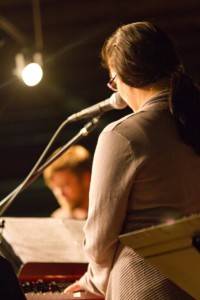You know we’re all about songwriting and modern hymns here at My Song In The Night. I mostly write about lyrics because I am a lyric guy. When songwriting, I typically write lyrics and then give them to Kristen or one of my other co-writers for the music. Sometimes I have melodic ideas and suggestions, just like my co-writer may have lyric suggestions, but for the most part I stick to lyrics.
So what does a lyric and hymn-text guy want tunesmiths and musicians to understand when they attempt to write melodies for pre-existing words?
Examine the lyrics and take your cues from the words. I mean this in two ways:
1. Understand the meter.
Let’s say you want to write a new melody for a hymn text that, according to your hymnal’s metrical index, is “Common Meter.” That means the poetic meter is 86.86 — alternate lines of tetrameter (eight syllables) and trimeter (six syllables).
But then look at the stress pattern of the syllables. Most likely the predominant unit of metric feet in a Common Meter hymn will either be trochaic (trochees) or iambic (iambs). A trochee is a two-syllable unit with the dominant stress on the first syllable:
- BOLdly
- NEver
An iamb is a two-syllable unit with the dominant stress on the second syllable:
- inSPIRE
- toDAY
You want to write a hymn tune that will work with the natural stresses of the syllables. Most Common Meter hymns are iambic, but even the predominantly iambic lines will contain occasional variations (for more on this, see my article Why Are Singers Putting The Wrong emPHAsis On The Wrong sylLAbles).
2. Examine the story plot and theme in the lyrics
This is so important and so overlooked. Write music that inhabits the same emotional territory as the lyrics (or that inhabits completely different emotional territory, if you’re trying to create ambiguity or irony – but it is dangerous to try this when writing congregational songs for worship).
The technical songwriting term for this is Prosody (the meaning of this word is different when used strictly as a poetry term).
Prosody: in modern songwriting, “the agreement between music and lyrics.”
Ask yourself what feelings the following three Common Meter hymn lines evoke:
Am I a soldier of the cross
A follower of the Lamb?
And shall I fear to own His cause,
Or blush to speak His name?
— above stanza from Isaac Watts, “Am I A Soldier Of The Cross“
Amazing grace! How sweet the sound
That saved a wretch like me!
I once was lost, but now I’m found;
Was blind but now I see
— above stanza from John Newton’s “Amazing Grace”
He bears between the Roman guard
The weight of all our woe;
A stumbling figure bowed and scarred
I see my Savior go.
— above stanza from Timothy Dudley-Smith’s “A Purple Robe”
Three common meter hymns, but each with a few different metrical substitutions and variations. Even more than that, though, these stanzas evoke different emotions, although they are all centered around the cross of Christ.
Sometimes (with a song like “Amazing Grace,” for instance) it’s difficult to “hear” the lyrics the way you’d understand them if the popular melody for the hymn wasn’t ingrained in your memory.
A visualization technique to help you to see the lyrics as the hymnist intended them:
Imagine a stream, flowing out of your brain. In this stream, boxes float away from your brain, around a bend, toward the horizon, ultimately to be lost at sea forever. Each box holds a popular hymn tune.
- There goes the tune for “Amazing Grace” (“New Britain”).
- There goes the tune for “Am I A Soldier Of The Cross?”
- There goes the tune for “Purple Robe.”
- There goes the tune for “Silent Night.”
- There goes the tune for “O For A Thousand Tongues To Sing.”
- There goes _____, and _____, and _____ …
All gone, forever. Now what are you left with? Just the words.
What do they make you feel? Jubilant? Angry? Anxious? Mournful? Whatever they make you feel is what they will make others feel — unless you write music that goes against the lyrics, in which case you’ll leave the worshipers confused or lead them to be caught up in the excitement of a good groove, without really thinking of the lyrics.
Recognize that if you’re aware of this, you have a good chance to create contemporary music for old hymns that actually honors the words of the hymn and makes sense (How many “tra la-la, la-la” tunes do we have, making light of lyrics that describe our Lord’s death in painstaking, laborious terms?)
If you’ll keep these things in mind, they should help you compose modern music for old hymns that won’t sound identical to other hymns.
But remember that if your goal is to write songs for congregational singing, it is more important to compose music that the average worship band can play and the average congregation can sing than it is to create worship music that sounds unlike anything that has come before.
Older generations knew this. That’s why a church congregation could immediately sing many Common Meter songs, for instance, using the same tune. In our quest for the Original, sometimes we forget the goal is to encourage God’s people to sing His praise. Originality is a good thing, but it is not an ultimate thing.
Make your melodies singable. Remember that many congregants do not know how to harmonize. They will sing the melody as best they can, in one octave or another. Some of the difficult hymn tunes of long ago were written in an age where congregants could sing multi-part harmonies — and even, in many cases, read sheet music or “shaped note” music. Not today.
For more on this (and for many other aspects of writing worship songs) I recommend God Songs: How To Write And Select Songs For Worship by Paul Baloche, Jimmy & Carol Owens.

